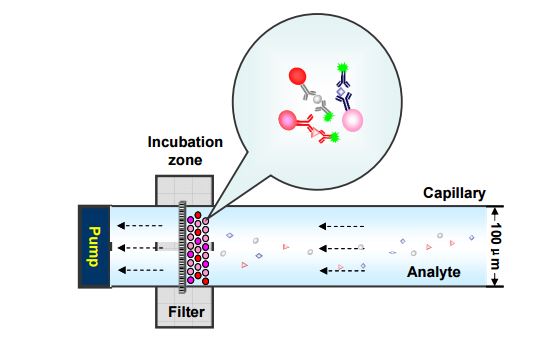Creative Biolabs has set up the advanced microfluidic microarray platform for the high-throughput and high-resolution B cell epitope mapping or other immunoassays service in a qualitative as well as quantitative way. This platform provides the opportunity to study thousands of potential peptide sequences in a single run by utilizing a limited amount sample. Several types of microarrays (such as microfluidic networks microarray, disc-based microfluidic microarray, microbeads microfluidic microarray) are available.
Microfluidic peptide microarray technique has emerged as a powerful tool in the field of disease diagnostics and epitope mapping. Compared with a microtitre-based immunoassay, the major benefits of the microarray are multiplexity (a couple thousand spots in the low-density array to 50,000 spots in high-density arrays), low sample volumes, robustness, and rapid methods. Our experienced research group provides the customized schedule for our clients to meet the corresponding needs. Once we receive the sample from our clients, we’ll synthesize a custom designed array and follow up by performing the peptide binding assay as request, collecting and analyzing the corresponding data, and deliver a final results report. The unique microfluidic biochip is employed in this technique and the target peptides sequences are synthesized on this biochip, which provides a miniaturized and automated analysis system for simple operation.
This microfluidic peptide microarray analysis has become popular in scientific research and clinical diagnosis due to the feature of quick, low-volume and high-throughput analysis of samples. Moreover, this method is very cost effective.
 Fig.1 Schematic illustration of the microfluidic array.
Fig.1 Schematic illustration of the microfluidic array.

The microfluidic platform developed by Creative Biolabs has been extensively used in the identification of specific substrate for a given antibody or the identification of immunodominant fragment of antigens. Furthermore, our microfluidic peptide microarray platform can help you detect the protein-protein interactions at the amino acid level. If you are interested in this platform, please contact us for more information.
Other optional CreMap™ B cell epitope mapping services:
Epitope mapping by microfluidic peptide microarray is a technique used to identify the specific regions (epitopes) on an antigen that are recognized by antibodies. This method utilizes microfluidic technology to arrange peptides on a microarray, allowing for high-throughput and precise detection of antibody-epitope interactions. The use of microfluidics enhances the efficiency and accuracy of epitope identification, which is critical for vaccine development and therapeutic antibody design.
Microfluidic peptide microarray technology involves the synthesis and immobilization of peptides on a microarray surface. These peptides represent potential epitopes of an antigen. When antibodies are introduced to the microarray, they bind to their specific epitopes. The interactions are then detected and analyzed using various techniques, such as fluorescence or chemiluminescence, to map the binding sites. Microfluidic systems allow precise control over fluid flow and peptide placement, enabling high-resolution mapping.
The microfluidic peptide microarray allows for high-throughput screening, enabling the analysis of thousands of peptides simultaneously. The microfluidic approach enhances the precision and accuracy of epitope detection by ensuring uniform peptide presentation and controlled fluid handling. This method also requires smaller sample volumes and reagents, making it cost-effective and suitable for limited sample availability.
Epitope mapping by microfluidic peptide microarray is beneficial for vaccine development, therapeutic antibody design, and diagnostics. It aids in identifying immunodominant regions of pathogens, understanding antibody specificity and cross-reactivity, and discovering new targets for immunotherapies. Additionally, this technique can be used to monitor immune responses and develop personalized medicine approaches.
Epitope mapping is crucial in vaccine development as it identifies the specific regions of a pathogen that elicit an immune response. By mapping these epitopes, researchers can design vaccines that target these critical areas, enhancing the efficacy of the vaccine. Microfluidic peptide microarray technology allows for detailed and high-throughput epitope mapping, accelerating the identification of potential vaccine candidates and improving the design of effective vaccines.
Traditional epitope mapping methods, such as phage display or peptide synthesis followed by ELISA, are often time-consuming, labor-intensive, and less precise. These methods may also require large amounts of samples and reagents. In contrast, microfluidic peptide microarray technology offers higher throughput, greater accuracy, and requires smaller sample volumes. The microfluidic approach also allows for better control over experimental conditions, leading to more reliable and reproducible results.
Microfluidic peptide microarray technology can be adapted for epitope mapping of virtually any antigen. The peptides representing potential epitopes can be synthesized based on the known or predicted sequence of the antigen. This versatility makes it applicable to a wide range of research areas, including infectious diseases, cancer, and autoimmune disorders, allowing for the detailed study of antibody-epitope interactions across different antigens.
Microfluidic peptide microarray technology improves the accuracy of epitope mapping by ensuring uniform and precise presentation of peptides on the microarray surface. The controlled fluid flow in microfluidic channels minimizes variability and enhances the reproducibility of antibody-peptide interactions. Additionally, the high-resolution detection methods used in this technology provide detailed and accurate mapping of epitopes, reducing the likelihood of false positives or negatives.
Use the resources in our library to help you understand your options and make critical decisions for your study.
All listed services and products are For Research Use Only. Do Not use in any diagnostic or therapeutic applications.
| USA:
Europe: Germany: |
|
|
Call us at: USA: UK: Germany: |
|
|
Fax:
|
|
| Email: info@creative-biolabs.com |
